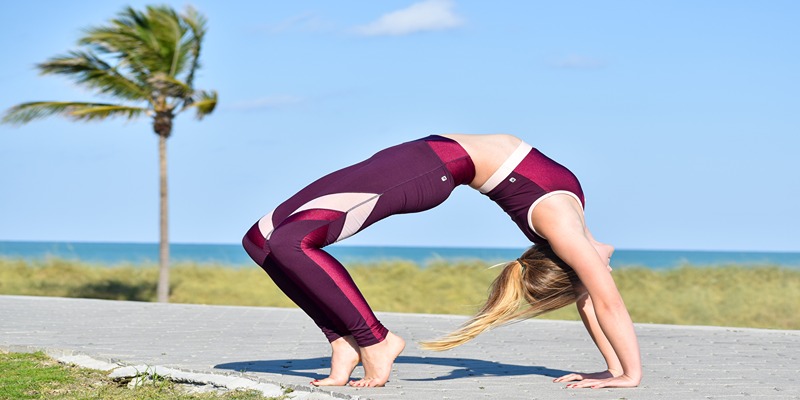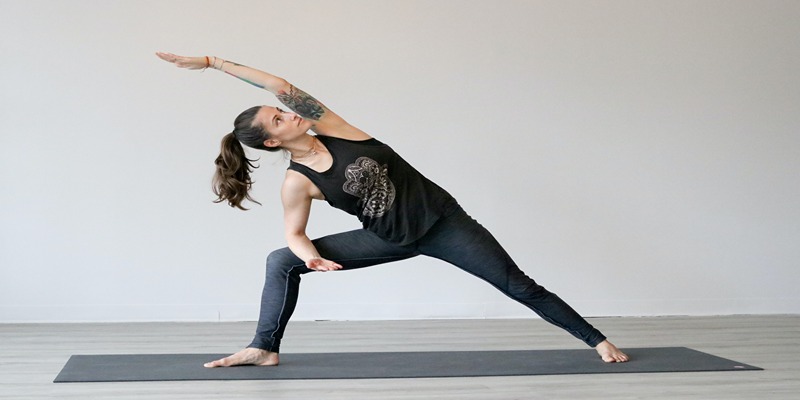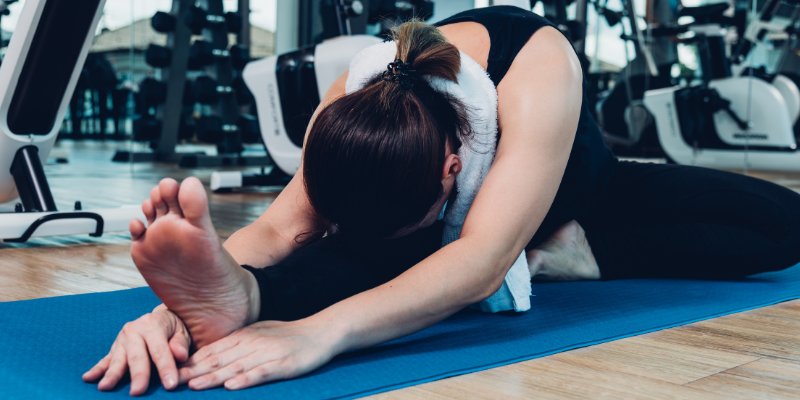Yoga Fusion: Enhance Your Practice with Exercise Ball Poses
Jan 04, 2024 By Nancy Miller
A unique combination of dynamic exercise ball usage and classic yoga positions yields new fitness benefits. This fusion—a combination of traditional methods and contemporary exercise equipment—introduces a novel strategy for wellbeing. It revivifies traditional yoga practices and amplifies the benefits of each position. We'll examine how incorporating an exercise ball into your yoga practice may enhance your balance, strength, and flexibility as we dig into this special combo. Read on to experience the life-changing potential of yoga ball fusion.

Essentials of Yoga Poses with an Exercise Ball
Understanding the Fundamentals
A familiarity with yoga's foundational concepts as well as the exercise ball's mechanics is necessary for incorporating the ball into yoga practices. The primary focus of this fusion is on core engagement and stability. Your core and other stabilizer muscles will come into play when you practice yoga on an unstable surface, such as an exercise ball. An increased focus on proper posture and breathing is necessary for this adjustment. Picking the correct size ball is critical; ideally, you want one that lets your knees bend at a perfect angle as you sit. Asanas may be tough, so beginners should start with easier ones and work their way up to more complex ones. A combination of focus, control, and composure is required to perfect this fusion, thus practicing mindfulness and patience is essential.
Key Benefits of Incorporating an Exercise Ball
There are several ways in which the use of an exercise ball may improve one's yoga practice, both physically and psychologically. On a physical level, it makes exercises more difficult by requiring more muscle activation and balance. Strength training at this level of intensity targets the abdominals, back, and stabilizer muscles in particular. In addition to helping you get into the right alignment in different postures, the exercise ball also makes it easier to extend your stretches farther. The mental aspects of mindful yoga practice, such as attention and body awareness, are enhanced with the use of an exercise ball. To keep people interested and motivated, this novel technique mixes up exercises with some fun and variation. With the ball's gentle support, certain yoga postures may be easier to do, allowing for a more gradual return to full practice for those healing from injuries. In sum, the exercise ball is an adaptable prop that enhances yoga's all-around advantages.
Yoga Ball Warm-Up Routine
The mind and body are ready for a more challenging yoga practice after a well-structured warm-up with a yoga ball. To activate muscles and improve blood flow, it incorporates light balancing exercises and stretches. Sitting on the ball and going for a little bounce is a good place to start. Engaging the core and stabilizer muscles is aided by this straightforward technique. Then, to open up the chest and lengthen the spine, switch to a set of sitting stretches including arm lifts and side bends. A ball-supported cat-cow stretch will help you activate your muscles more deeply while also warming up your back and increasing your spinal flexibility. To build stability and be ready for more difficult poses, include some balancing exercises, like sitting with one foot lifted off the ground. In addition to preparing you for the restorative yoga practice that will follow, this warm-up sequence improves your flexibility and balance.
Core Yoga Ball Poses for Beginners
Basic Asanas Enhanced with a Ball
Core asanas are already challenging enough without adding a yoga ball, but novices may increase the difficulty and reward by using the ball. To increase the engagement of the glutes and lower back muscles, begin with the ball-assisted bridge posture, in which the legs are lifted on the ball. To further enhance spinal mobility and core stability, go to a sitting twist on the ball. Another way to modify the child's posture is to use a ball. By extending the arms over the ball, you may deepen the stretch along the spine and shoulders. To increase flexibility and relieve back pain, try a light forward bend using a ball for support. As a last option, you may utilize the ball to do a modified plank. Resting your forearms on the ball will increase the stability difficulty. With the help of a yoga ball, these easy positions become even more of a full-body exercise that improves flexibility, stability, and core strength.
Safety Tips and Modifications
When doing yoga on an exercise ball, it is really important to be safe, particularly if you are just starting out. The ball should be firm yet somewhat give when inflated, so check that first. For safety reasons, you should never workout on a slippery surface; otherwise, the ball might move around suddenly. Take it easy at first to get used to the extra instability in each stance. Modifications may be made to poses if they seem excessively demanding. For example, in balancing postures, keeping one foot on the ground adds support. If you need more stability, you may use the ball to hit a wall. You must pay close attention to your body and refrain from straining or overstretching. Get out of that position right away if you feel any kind of pain. If you find that you are having trouble breathing during exercise, you should ease down on the intensity. Finally, it's a good idea to seek the advice of a yoga teacher or fitness expert when you first begin so that you may get tailored adaptations and helpful pointers.

Advanced Yoga Fusion Techniques
A great option for advanced yoga fusion practitioners to increase their flexibility and strength is to use an exercise ball. These difficult positions call for a high level of physical skill as well as concentration and self-awareness. The stability ball pike is one such posture; it's like a hybrid of the inverted V and the leg-supporting ball stance. Your abs, shoulders, and arms will get a good workout in this position. From the plank position, you may go into a stability ball jackknife by drawing your knees to your chest. This will put your abs to the test even more.
As an additional advanced move, you may try the warrior III position with a ball. The difficulty of this posture is increased by balancing on one leg while the other is on the ball. This requires more power and focus from the supporting leg. By switching things up a little and putting the ball between your hands and shins in the crow posture, you may increase the difficulty of the balancing challenge and strengthen your core muscles all at once.
In addition to developing incredible strength, especially in the lower body and core, these more advanced postures also greatly enhance flexibility and balance. By continually challenging the body to adjust to its changing shape, the exercise ball helps to enhance proprioception and overall control. Although difficult, these methods expand the boundaries of yoga practice.
Conclusion
Integrating yoga poses with the use of an exercise ball offers a fascinating way to elevate conventional yoga routines. The mental and physical components of yoga are enhanced by this combination, which presents a new challenge that promotes greater strength, flexibility, and awareness. Whether you're just starting out or have been practicing for a while, using an exercise ball may give your routine a whole new dimension. Discover a fresh approach to yoga that will revive your feeling of balance and well-being. Keep moving forward mindfully and enjoy the ride of self-discovery and development.
On this page
Essentials of Yoga Poses with an Exercise Ball Understanding the Fundamentals Key Benefits of Incorporating an Exercise Ball Yoga Ball Warm-Up Routine Core Yoga Ball Poses for Beginners Basic Asanas Enhanced with a Ball Safety Tips and Modifications Advanced Yoga Fusion Techniques Conclusion
Kombucha: 5 Powerful Health Benefits of This Probiotic-Rich Beverage

Do Lactic Acid Buildups Cause Post-Workout Muscle Soreness?

A Possible Reasons For Always Feeling Tired And Their Impacts

Eating Right for Eczema: Best and Worst Foods Revealed

Easy Pool Workouts For Quick Fat Burn

Understanding Pronation and Overpronation in Walking and Running

Discovering Squat Variations: 7 Alternatives to Barbell Squats

Daily Beneficial Yoga Poses for a Healthy Routine

Nausea After A Workout: Causes, Remedies, And Prevention

Cinnamon and Weight Loss: Exploring Myth and Reality

Combat Anxiety and Depression Through Physical Activity
